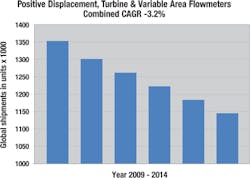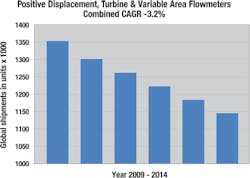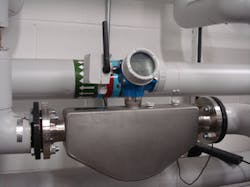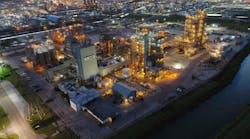The need to replace installed process control instrumentation because of failure, unreliability or unacceptably high maintenance can justify the cost of the replacement even in the harshest of economic conditions. The measurement may be critical to the quality, productivity or safety of a vital manufacturing process, and would typically qualify for expenditure under maintenance, repair and operations, commonly abbreviated as MRO. This article considers the significant potential for MRO that exists among the extensive installed base of older mechanical flowmeters, where the existing flowmeter technology was once the best or only solution for a particular application, but now, for several possible reasons, it no longer is.
Tough Decisions in Tough Times
A further appreciation of the MRO potential can be gained from considering the challenges faced by manufacturers in the process industries, where operating profit or even survival can depend upon improving their cost position. If the product quality or productivity of a process plant must be improved, then a more accurate or more reliable flow measurement may be a key component. Scheduled or unscheduled process stoppages can be necessary when, for example, a flowmeter requires essential maintenance, calibration, or outright replacement. Such process downtime can be extremely costly. Consider a process with a typical liquid flow velocity of around 6.0 feet/second in a standard two-inch Schedule 40 line, giving a flowrate of around 4,000 gallons per hour. If the product in question has a value to its manufacturer of just $0.95 per gallon, then the loss in revenue could be $3,800 for every hour the process is stopped. Beyond the lost revenue from the process stoppage, there is the cost of maintaining, calibrating, repairing or replacing the meter itself, and possibly environmental cost implications for safe disposal of hazardous product released from the process line during the operation.
Consider also that in exploring all possible ways to reduce costs, companies will attempt to switch between fuels used for, say, process heating operations, according to fuel cost and availability at the time of purchase. This can mean significant variation in fuel properties, such as density and viscosity, and fluid temperature variation is, of course, a related influence. Thus, an older flowmeter technology that exhibits significant fluid property dependence is inappropriate when fluid variations apply and will give rise to poor or even unsafe process control. If we take the illustration of process financials in the paragraph above, we have revenue of $3,800 per hour, so for every week of production comprising five days of eight-hour shifts, we can see that a 1 percent measurement error represents $1,500 per week, or $70,500 for a year comprising 47 weeks. For older mechanical technologies, metering errors of 1 percent are modest, and errors of 10 percent and greater can result from uncompensated changes in fluid property.
Let us also consider flowmeter installation conditions with regard to MRO. With the exception perhaps of PD, the older technologies are significantly impacted by flow profile disturbance. In the past fifty years, our knowledge has significantly advanced in the area of fluid dynamics, thanks to extensive research programs and the development of visualisation technology such as CFD (Computational Fluid Dynamics). This advance in knowledge has allowed us to improve our understanding of individual flowmeter technology behavior in relation to flowing fluid conditions, and thereby assess the impact of disturburances, such as velocity profile asymmetry or swirl, caused by common process pipe-work components, typically valves, elbows and pumps. Armed with this knowledge, many plant operators have become aware of serious shortfalls in the installed conditions of their older flowmeters, and sometimes, for this reason alone, they need to update their process plant control with a more reliable and accurate technology.
Aiding the Transition
The older flowmeter technologies mentioned above all have one thing in common, namely that they function as two-wire devices utilizing only loop-power. Modern flow meters operating on the vortex and electromagnetic principles have been available in two-wire, loop-powered form for a considerable time. However, the world’s first two-wire, loop-powered inline ultrasonic flowmeter was introduced in 2006, and the first true, two-wire, loop-powered Coriolis flowmeter was only introduced in the summer of 2010. Ultrasonic and Coriolis technologies respectively are number one and number two in flowmeter market growth.* They offer greater operational reliability, no moving parts exposed to the process fluid, a wide operational range, fluid property independence, a simplified pipe-work installation, and virtually maintenance-free operation, thus reducing cost of ownership. Further, integration of these technologies in existing two-wire architecture is not only simple, but also offers the ability to advance the plant controls platform through modern communications protocols such as HART and Profibus.
Where the Opportunity is Greatest
From accumulated process data and the flow meter technologies applied, it is estimated that 25 percent of all liquids in chemical and petrochemical plants are non-conductive and many fluids will tend toward significant viscosity. When considering the modern technologies for this applications group, electromagnetic and vortex flowmeters would be inappropriate. Based upon size distribution statistics for flowmeters supplied to the chemical industries, it is estimated that 60 percent of all pipes found in a process plant will be two-inch or smaller. Ultrasonic or Coriolis technology can provide the solution, and given the growing preference for two-wire, loop-powered instrumentation in the chemical sector particularly, there is specific benefit not only from the simplified system integration, but also from the certified intrinsic safety, which is provided by the devices in such installations.
The cost-benefit of these technologies in respect to power supply and cabling requirements can be appreciated by comparison with costs for the provision of power supply for an alternative four-wire device. In 2003, WIB/EXERA (International Instrument Users’ Associations) Report T 2732 x 03 was published, and it provided an average survey of prices quoted in projects at that time for the provision of power supply for four-wire instruments. The price ranged from $1,600 to $2,400 per flowmeter, depending on design and plant characteristics. We can assume that these costs will not have reduced in the seven years since, and therefore $2,000 is a conservative figure to use. Where the flowmeter is being installed on an existing, operational process as a replacement or additional metering asset, thus eliminating the need for new cable supply and installation work, plant Instrument Engineers have testified separately to cost savings in respect of cabling work having a similar range to that of the power supply.
The two-wire, loop-powered ultrasonic transit-time flowmeter will deliver a volume flowrate measurement with a traceable, calibrated accuracy of better than 0.5 percent of rate. A straight-pipe inlet run of only five diameters is required in most cases, and virtually any liquid can be measured over a wide range of flowrates, pressures and temperatures. It is a full-bore meter, thus creating no pressure drop, and non-intrusive sensing elements preclude line blockages due to suspended particulate matter. Since its introduction in 2006, it has found particular acceptance in tank-farm operations for vehicle loading-arm applications. Road or rail tankers are often weighed when entering the facility to establish zero or "tare weight," filled at the loading arm, and then weighed upon leaving the facility to establish a custody-transfer amount.
The measurement objective here is safe, optimized filling and maximized vehicle payload. Legal limits for tanker loading exist in many countries (e.g., 96 percent in Mexico). Without a reliable flowmeter to provide totalized flowrate, the operation becomes labor-intensive and potentially inaccurate via tank level or even manual sight glass readings. Occasionally, a tanker will enter the facility and deliver liquid product into the tank farm, thus demanding a bidirectional flowmeter. The ultrasonic transit-time flowmeter satisfies these needs and provides improved, more reliable performance to the mechanical devices utilized previously. Where even better measurement performance, or indeed a direct mass flow measurement, is required, perhaps for custody transfer purposes, or where the preferred installation location offers no straight-pipe run, then the two-wire loop-powered Coriolis technology is ideal.
Another application area where these two modern flowmeter technologies bring great benefit is that of fuel supply monitoring to steam boilers or process heaters. As stated earlier, the increasing need to minimize operating costs may result in variations of fuel type purchased for plant operation according to price and availability, which in turn results in variations of fluid property, and sometimes fluid quality in terms of cleanliness. A flow measurement device that is fluid-property dependent, or rendered inoperable or damaged by a dirty fluid, is not suitable in such circumstances. All the older technologies described earlier will fall into this category. An inline ultrasonic transit-time ultrasonic meter has proven to be a very acceptable technology for fuel oil monitoring, and it has successfully replaced numerous mechanical meters during the past few years. A large petrochemical manufacturer in Hungary has replaced its process heater fuel oil meters in three phases since 2008, proving by the decision to continue with phase two that the technology is a success. The two-wire loop-powered Coriolis meter provides even better flow control, being not only twice as accurate, but also measuring direct mass flow, thus eliminating the issue of volume correction for temperature and offering enhanced combustion control in the face of fuel density or viscosity variation. Further, the Coriolis meter will measure mass flow of gaseous fuels, such as natural gas, where being measured independently of fluid properties, including pressure, has added benefit. A Coriolis flowmeter can be installed without straight inlet or outlet piping (Figure 2), as the velocity profile has no influence on its performance.
Technology to Take us Forward
It is worth reiterating that the modern flow technologies like ultrasonic, Coriolis, electromagnetic and vortex, functioning as two-wire, loop-powered devices, all offer the capability for plant modernization. The cost-effectiveness of process plant control is transformed with improved data access, visualization and interaction with remote instrumentation. Through the use of 4-20 mA HART, it is possible to remotely interrogate and configure the instrumentation across a complete process plant from one central computer. The visualisation and interaction increases further through advanced protocols like Profibus and Foundation Fieldbus.
Ultrasonic and Coriolis technologies provide instrument engineers with vital self-monitoring information. The format of such information is easier to understand and act upon when presented in accordance with harmonized international guidelines for online plant asset management (i.e., NAMUR). Through more precise specification of their signals, modern flowmeter technologies provide more detailed meter diagnostic and process-related information. These details make it possible for instrument engineers and operators to take action at the appropriate time; immediately or during the next scheduled shutdown, saving time and money by knowing the exact health of their measuring point. WirelessHART technology now makes it possible to add a measuring device to an existing process without any cabling whatsoever (Figure 2).
Where a process plant has a large installed base of older mechanical technologies, the decision to embark upon a program of replacement toward plant modernization cannot be taken easily. There are the stocks of spare parts to consider along with the plant instrument technicians who are trained on, and at ease with, the old devices. While the new ultrasonic or Coriolis two-wire devices cannot be installed without the pipe being emptied and perhaps a flange being re-welded, the major cost of cable and power supply installation is avoided, and the benefits of improved plant operation can be realized. A process plant that retains the older technology going forward will be at risk and may find it increasingly difficult, or even impossible, to maintain a cost position that competes effectively in the global market.
Steve Milford is an International Business Development Manager for Endress+Hauser AG, of Reinach, Switzerland. He has been involved continuously in flow measurement applications since 1983. He currently specializes in ultrasonic flow measurement technology. He is actively involved with standards development committees within ISO and the British Standards Institute, and has made significant contributions to published international standards during the past decade. During that period, he has also authored numerous technical papers and articles focussed on ultrasonic flow. Mr. Milford can be reached at [email protected].




